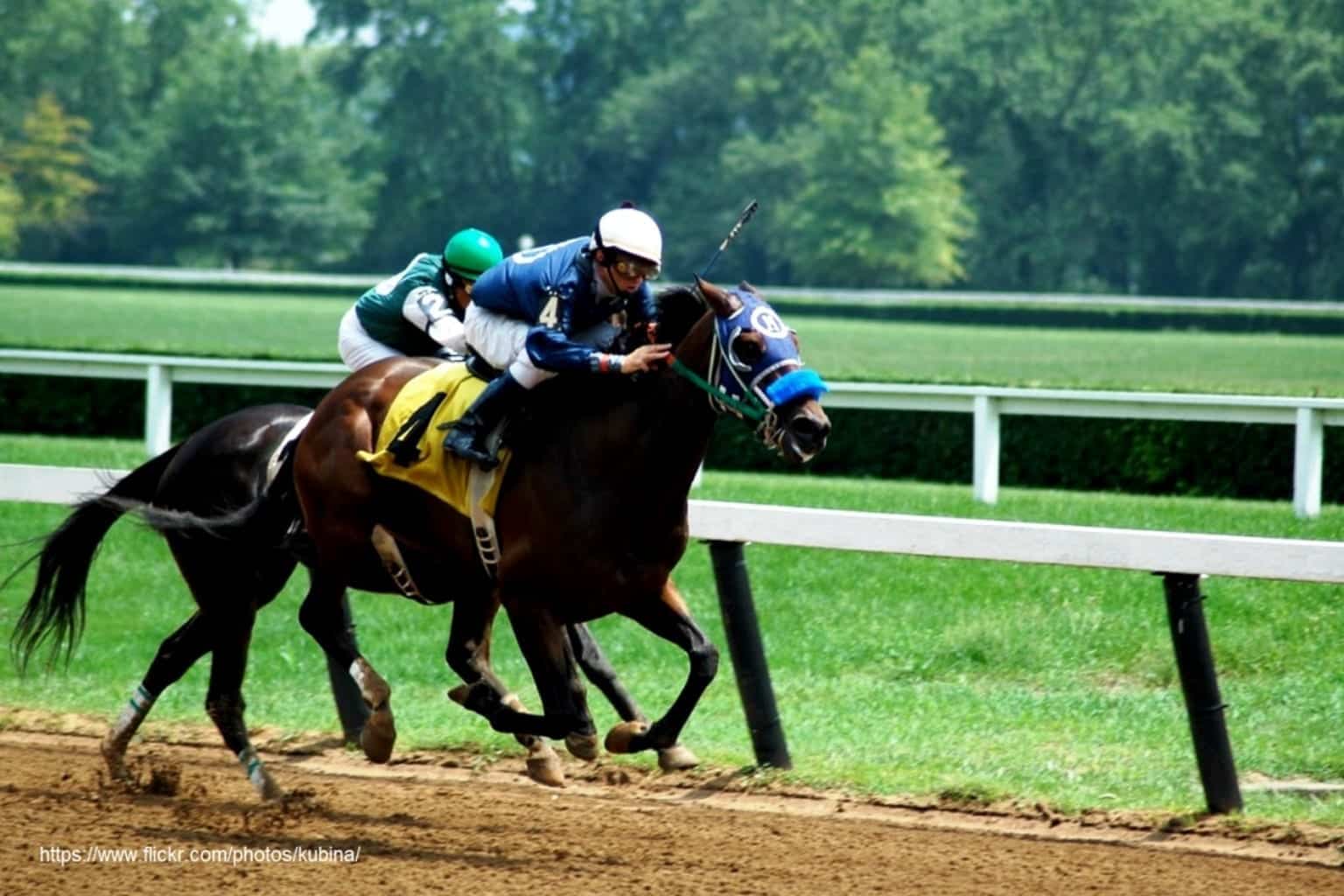Stayers on the Flat
I am revisiting an article I wrote a couple of years ago regarding trainers that excel with their stayers on the flat and on the all-weather (AW). The reason for that is two-fold.
Firstly, the trainers I highlighted did well and made me a few quid, and, secondly I have had another 2 years to hone my skills at mining data from Horse Race Base and it is well worth applying the knowledge I have gained in recent years to a system that worked quite well last time.
As regular readers are well aware, I am a jumps fan more than a flat racing fan but as a tipster you have to cover both codes. Of all the types of flat racing, the staying races are the ones I prefer to bet on. It may simply be a case of getting more for your money’s worth as the races obviously take longer to complete.
For some unknown reason I also seem to be better at picking winners in races of 1m 4f upwards compared to sprint races, mile races and those other middle distances shy of a mile and a half. The other thing I like about staying races is that hard luck stories such as draw bias, traffic problems and interference do not have the same profound effect that they can have in races up to a mile.
In a sprint race, your bet can be over within the first few seconds if your fancy is slow out of the gate or stumbles leaving the stalls. That is one of the most frustrating sights to a punter.
Such slowly away or clumsy types in staying races, however, have plenty of time to recover. Another frustrating sight is seeing your fancy fly home after being left with too much to do or failing to get a run at a crucial time.
Again, over longer distances there is plenty of time to come from off the pace or eventually get a run even if the horse is checked a couple of times.
So, rant over, and on to Horse Race Base.
I have looked at all races run over distances of 1m 5f and upwards on the flat and AW in both the UK and Ireland since 2010. As always, it is the trainers I am after for my notebook and the conditions or particular type of horse to follow.
I am not necessarily looking purely on profit but looking for a good strike rate, a respectable return on investment and consistency.
The latter is one of the pitfalls of system creation.

Always eyeball the results to look for consistency rather than a hit and miss profile. I am conscious that the flat season may well be over by the time you read this, so I have included plenty of AW action to see us through until next year.
So, these are the trainers that have gone into my tracker for the next 12 months and the conditions to note when they send out runners over staying trips.
Mark Johnston
Mark Johnston is almost impossible to get a read on. His horses run a blinder, then flop, then bounce back when you least expect it. One thing is a given though, his horses are tough, especially the stayers. What we need to do however is head over to the AW to find some decent profits.

Above you will see Mark Johnston’s record with horses racing on the AW over trips of 1m 5f or further.
His 10-year strike rate is 24% and the P/L at Betfair SP is £111.74 to £1 level stakes.
What really impresses me however is that ROI of 46%.
For every £100 staked you would have returned £145.99. I could simply leave it there, but it is well worth exploring the data a little more.
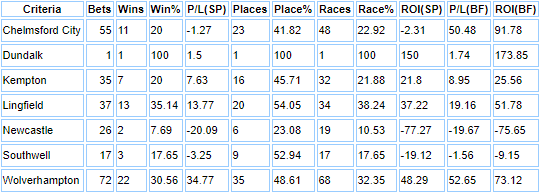
First, we find that Newcastle, the UK’s newest AW racecourse if you like, is not a happy hunting ground with just 2 winners from 26 runners. I think it is safe to eliminate that one.
His Southwell record is in decline with fewer runners and fewer winners so that course can go too.
Next up is race class. The trainer is 0-2 in Class 1, 0-1 in Class 7 and although he has a 29% strike rate at Class 6 level, these runners show an overall loss. So, I am sticking to Class 2 down to Class 5 races.
All bar four winners have come in races with 5 to 13 runners.
Winners have come in handicap and non-handicap races and the age of the horse has no real bearing on its chances of winning.
I am going to leave it there as other filters I have explored such as the number of runs in the season, career runs, career wins and previous track form do not make any difference to the overall outcome, the results of which are shown below:

We have lost a few winners along the way by adding in our filters, but we now see an ROI just south of 100%. The strike rate is a respectable 27% and we should get around 12 to 15 bets a year.
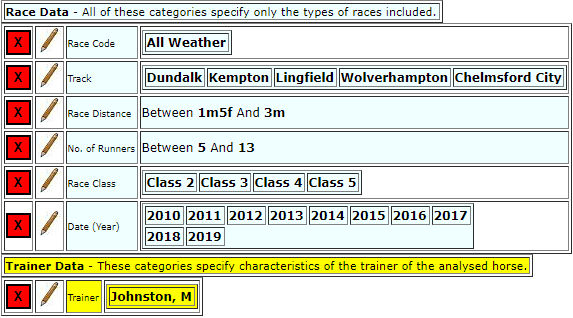
System 73: Mark Johnston runners at all AW tracks except Southwell and Newcastle, racing at class 2 to class 5 level over 1m 5f or further in fields of 5 to 13 runners.
Willie Mullins
No stranger to success on the flat, Willie Mullins 10-year figures are all the more interesting given he made a loss with such runners in 2010, 2011 and 2012.
His 10-year stats are shown below:

If we concentrate on 2013 to 2019, we see that his 7-year stats are as follows:

When we remove those lean years, we see that his performance has improved markedly in terms of the ROI which has nearly doubled. In fact, he has targeted some of the big staying handicaps at the big flat festivals and also likes a crack at the Cesarewitch, Pitmen’s Derby and Ebor to name but just a few of the big prized staying handicaps.
A 20% strike rate is very good given the competitive nature of many of the races he targets.
Over in Ireland there are a number of festivals that he targets, particularly the Galway Festival and the 4-day festivals at Tramore and Killarney. More on that later.
When looking a little deeper into the results we find that he is just 3-23 with horses aged 9yo and older.
So, we will focus on those aged between 3yo and 8yo.
The other thing to note is that all winners had raced no more than 14 times on the flat. That may seem an excessive upper limit, but we are dealing with older horses in the main, and those with more than 14 starts are 0-21.
We can also add to that the fact that all bar one of the Mullins winners had won no more than 4 previous flat starts.
So, we have tweaked a few things, most likely eliminating the older more exposed runners and that leaves us looking at the following set of results for the last 7 years:

What I want to do next is concentrate on those courses where he has a better than average strike rate compared to his strike rate across all the courses where he has sent his flat stayers.
42 of the 51 winners have come at the following courses: Ascot, Ballinrobe, Curragh, Galway, Gowran Park, Killarney, Leopardstown, Listowel and Tramore.
That leaves us looking at the final set of results for our Willie Mullins micro-angle:

This produces a system with a 29% strike rate and an ROI of over 100%.
It will be interesting to see how it goes over the next 12 months as we know Mullins is no flash-in-the-pan and always has good horses in his yard.
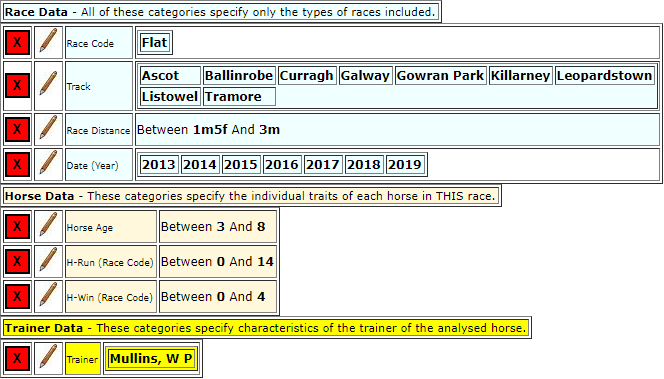
System 74: Willie Mullins runners in races over 1m 5f or further, aged 3yo to 8yo, no more than 14 previous flat starts, no more than 4 previous flat wins, racing at Ascot, Ballinrobe, Curragh, Galway, Gowran Park, Killarney, Leopardstown, Listowel and Tramore.
Hughie Morrison
Hughie Morrison made it onto our list last time and he is always one whose runners’ interest me over marathon trips.
His bare figures may not seem that spectacular in terms of the number of winners, strike rate and P/L compared to some of the other trainers we will be looking at, but he is my Number One go-to guy in these races because he consistently wins his fair share year-in and year-out. He also tends to target the big prize staying handicaps with a lot of success.
We will begin by looking at his overall record in races over 1m 5f and further both on the flat since 2010.

We see above that he more or less breaks even at Betfair SP (small loss overall).
However, ditching the non-handicap runners has an immediate positive effect:

As you can see, the majority of winners and all of the profits have come in handicap races and we will concentrate on those. Next, we find that he is 2-26 over trips of 1m 5f and 1m 5 ½f. The profits start at 1m 6f.
Perhaps the most telling statistic is that 27 of the 29 winners in 1m6f+ handicaps were aged 3yo or 4yo. The older horses are 2-59 so they are clearly ones to avoid. That nudges his strike rate up to nearly 20%.
If we also factor in the observation that all 27 winners went off at an industry SP of 11/4 to 16/1 and all the profit came in 3yo only and 3yo+ handicaps, we end up with the following set of numbers:

These filters do limit the amount of action in any one year, but the strike rate is 25% and the ROI is well over 100% so it could be well worth the wait for a qualifier or two to come along.

System 75: Hughie Morrison runners aged 3yo or 4yo running in 3yo or 3yo+ handicaps over 1m 6f or further and sent off at industry SP odds of 11/4 to 16/1.
John Gosden
If you want a more straightforward approach, then John Gosden is a master trainer in staying races. His bare figures for the flat (not AW), without any additional filters, are shown below:

He does not run as many as some trainers, particularly the likes of Mark Johnston, but he is operating at a 23% strike rate and you certainly get your money’s worth with level stakes profits of £95.51 and a 36% ROI.
It does not seem to matter if he is running them in a handicap or a non-handicap race as you can see below. There is a nice even split between runners in the two types of race and the number of winners, placers, P/L are fairly similar.

It is possible to improve slightly on the bare figures if we strike a line through those races run over further than 2 miles.
His record in these races is not bad (7 winners from 41 runners) but these runners make a small loss so ignoring these races will increase the ROI. In fact, sticking to races between 1m 6f and 2 miles produces an ROI of 47%, which is good in anyone’s book.

There is not a lot else to say about John Gosden’s stayers other than we can improve the results slightly by sticking to those sent off at an industry SP of 16/1 or shorter.

The one potential micro-angle bubbling under the surface of those impressive results is the tracks where he does best.
Those include Ascot, Doncaster, Haydock, Newmarket’s July and Rowley Mile courses, Nottingham (where he sends a lot of his younger runners) and York. Combining those courses gives us the following results:

As you can see, we lose just 8 winners from the system, but we increase the strike rate to close to 30% and the ROI nearly goes through the roof at a high of 92%.
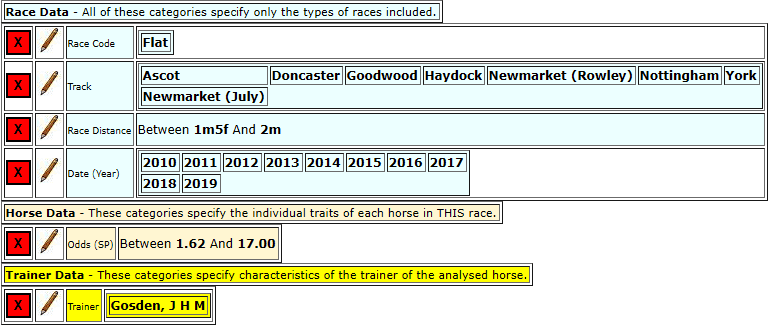
System 78: John Gosden runners in races between 1m 5f and 2 miles, sent off at 16/1 or shorter at Ascot, Doncaster, Haydock, Newmarket’s July and Rowley Mile courses, Nottingham and York.
Nick finds us four further worthwhile systems to add to our portfolio for our Gold readers this month.
You can upgrade to On Course Profits Gold here… https://www.oncourseprofits.com/upgrade-to-gold/
If you’d like to bet alongside Dr Nick at all the big meetings this year, check out his Big Race Tips service which made 1,361 points profit since January 2016 – Click Here.


